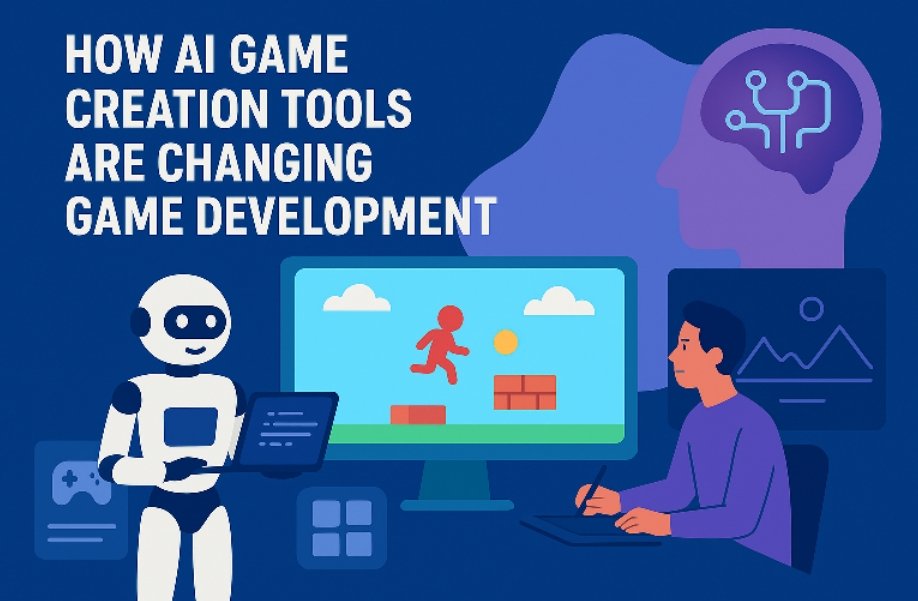Artificial intelligence is reshaping how modern games are built. Instead of spending months creating models, coding systems, or designing levels manually, developers can now describe their ideas in plain text and watch AI turn them into playable elements. This new creative method allows beginners and professionals alike to build worlds faster and more freely than ever before.
Understanding Prompt-Based Game Creation
AI game creation is the process of giving AI a text description and receiving a functional result. When a developer writes something like “create a neon-lit sci-fi alley filled with flying drones,” the AI interprets the prompt and produces textures, layouts, lighting, and even interactions. Game development becomes conversational rather than strictly technical, allowing creators to focus on imagination and direction.
Why AI Tools Matter for New Developers
For newcomers, traditional game development can feel overwhelming. There are engines to learn, scripts to write, and assets to design. AI removes many of those barriers. Anyone who can describe a scene or character can begin building a game. This gives storytellers, artists, and students a path into game creation without needing years of training. It also keeps motivation high because progress appears quickly.
How Professionals Use AI to Accelerate Workflows
Experienced developers also gain major advantages from AI. Tasks that normally take hours—like environment setup, dialogue writing, lighting design, or NPC behavior—can now be generated in minutes. Professionals still refine and polish the results, but AI handles much of the heavy lifting. This allows studios to expand their creative vision while reducing production time with platforms like Astrocade.
AI and the Evolution of World-Building
World-building becomes much smoother with prompt-driven tools. Developers can describe landscapes, cultures, weather systems, and architectural styles in simple sentences. The AI then generates a world template that reflects those ideas. A creator can define a frozen wasteland ruled by elemental spirits or a floating city powered by crystal engines, and AI will produce the initial layout. Refinement happens through more prompts until the world feels complete.
Creating Characters Through Natural Language
Characters are the emotional engine of every game. With AI, developers can write a short description of a personality, appearance, or role, and the system generates a character model, voice style, or behavioral pattern. A mysterious wanderer or a robotic trader can come to life instantly. This keeps character development intuitive and centered on narrative depth rather than technical barriers.
Designing Gameplay Systems With Simple Instructions
Gameplay mechanics can also begin as natural-language instructions. A designer might write “the player loses warmth during storms” or “enemies grow stronger when night falls.” The AI converts these ideas into mechanics that can be tested instantly. This supports rapid experimentation and helps developers refine the feel of the game without long coding sessions.
Testing and Refining AI-Generated Worlds
Even with advanced AI, refinement remains essential. Testing helps developers identify what needs balancing or improvement. If something feels unclear or unpolished, new instructions guide the AI to adjust it. This quick loop makes polishing easier, allowing creators to fine-tune worlds, characters, and mechanics at an accelerated pace.
The Rising Impact of AI on the Game Industry
AI is changing how teams are structured and how fast games can be produced such as Duck Uprising. Indie creators can now compete with larger studios by building content more efficiently. Big studios can produce richer worlds without increasing workload. This shift marks the beginning of a new era where creativity becomes the driving force and technical limitations fade into the background.
What the Future of AI Game Creation Looks Like
As AI evolves, we can expect even deeper world-building capabilities. Developers may use chained prompts to define entire histories, factions, and mission structures. Players might even shape game worlds themselves through natural language during gameplay. The gap between imagination and execution will continue to shrink as these systems grow more intelligent.
Conclusion: Imagination at the Center of Creation
AI-driven game creation is turning simple prompts into complete worlds. Developers can focus on storytelling, atmosphere, and creativity while AI handles complex tasks in the background. This partnership opens the door to new creators, speeds up professional workflows, and leads to games fueled by imagination rather than technical difficulty. The future of game development is becoming faster, more accessible, and more creative as prompt-based methods take center stage.

